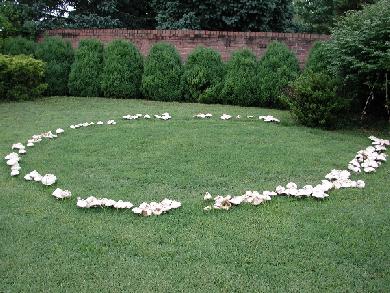 [S]
[S]
Understanding Fairy Rings
by Grandpa Cliff 17 April 2006
 [S]
[S]
[Note: It is not necessary for teenagers to learn the words in italics.]
Mushrooms sometimes grow in a circle called a Fairy Ring. In England it was believed by some that the mushrooms appeared where fairies had recently danced in a circle. Another version of the myth was that the fairies danced inside the circle of mushrooms, and that the mushrooms were seats used by the tiny fairies when they needed a rest from the dancing.
Fairy rings appear rather suddenly, so stories were made up to explain these mysterious and fascinating rings. In countries other than England, they were thought to be made by such forces as lightning, meteorites, witches, sorcerers, and the devil. It was generally believed to be bad luck to enter a ring of mushrooms, and some believed that the milk of cows grazing inside the ring would not be drinkable. But, some people believed that a house built in a field that has a fairy ring would have good luck.
Fairy rings grow in lawns, meadows, and even in the woods. A fairy ring in France is said to be almost a half mile wide and about 700 years old.
Mushrooms are Fungi
To understand how fairy rings develop, we need to know more about the growth of mushrooms. Since they don't have chlorophyll (they aren't green), mushrooms can't make their own food in sunlight by the process of photosynthesis. Mushrooms are fungi, and they grow in soil that contains buried organic matter such as dead wood, dead plant leaves and dead roots. All of these are food to mushrooms.
The part of the mushroom that is above ground is only present for a few days each year. Its job is to reproduce (make new mushrooms). It grows up quickly, drops its spores (which function like seeds), and soon disappears.
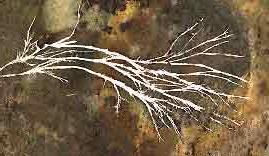 A
thread-like hypha
[HIGH-fuh] grows from the spore. Much branching occurs as
A
thread-like hypha
[HIGH-fuh] grows from the spore. Much branching occurs as
the hypha grows into the soil. A great number of hyphae [HIGH-fee] develop.
[hyphae is the plural of hypha] The photo at the left shows some hyphae that were
found growing in the moisture between two leaves that were stuck together.
Normally, the white hyphae of a mushroom are in the soil and not easily found.
[S]
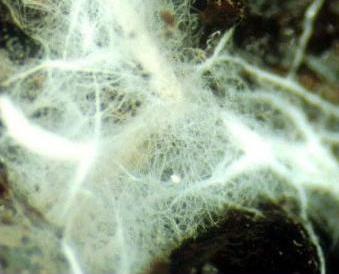
As the hyphae crisscross each other, they form an interwoven mat called a mycelium [my-SEE-lee-um] that can grow large enough to eventually cover an acre or more. The photo at the right shows a small part of a mycelium. This underground structure is the main part of a mushroom. It is present year round and can survive for many years.
How do Mushrooms Get Their Food?
Like your stomach, the hyphae produce digestive enzymes. The enzymes pass through the cell membranes of the hyphae, then through the cell wall of the hyphae, and then into the soil. There, the enzymes digest the organic matter (rotting wood, etc.), changing it into nutrient molecules that will dissolve in water and are small enough to pass back into the cells of the hyphae. These nutrients are the food of mushrooms.
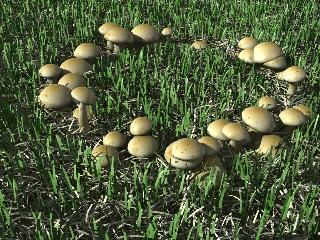 Forming a Fairy
Ring
Forming a Fairy
Ring
At first, a spore lands near the center of the future fairy ring. After a mat of
hyphae has grown, a mushroom or toadstool may appear on the surface of the
ground and then quickly disappear. The mycelium (underground hyphae)
keeps spreading from that central point. By the next year, a small cluster of
mushrooms may appear. But, the hyphae keep growing outward from the
center. The next year a small circle of mushrooms might be seen. The
hyphae continue to grow, so the following year the circle of mushrooms is a
little bigger. And each year after that, the circle enlarges. The mass of
hyphae (mycelium) gets wider each year, but the mushrooms only form at the outside edge. Therefore, they tend to have a circular arrangement. [S]

Why is the Grass Sometimes Greener inside the Fairy Ring?
[S]
When the soil's dead plant material is digested, nutrients are released. Nitrogen, in the form of nitrate, is one of those nutrients. The hyphae absorb some of it, but so do the roots of grass and other plants growing nearby. Nitrate is a kind of fertilizer. Once absorbed, the nitrate makes the grass greener and taller than grass that is not receiving as much nitrate. In the photo at the right, it is easy to tell that the grass is greener inside the fairy ring.
Fairy Ring With a Circle of Greener Grass
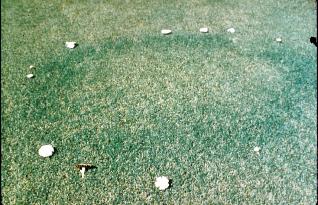 The previous photo
showed that the nitrate was available everywhere inside
The previous photo
showed that the nitrate was available everywhere inside
the fairy ring. The photo at the left has abundant nitrate just inside the fairy
ring, but the central grass is not getting much. This may happen for a
couple of reasons. First, the mycelium sometimes gets so dense that water
and nutrients can't get up through it to the grass roots. Second, some soils
don't have much organic matter in it to begin with. In that case, the organic
matter that was near the center has previously been digested and very little
may remain.
[S]
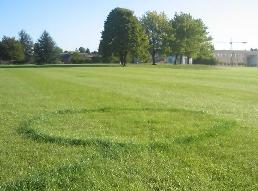
The photo at the right was taken at a time of year when the above-ground part of the mushrooms was absent. But, nutrients are being released near the edge of the mycelium, so a healthy ring of dark green grass is present.
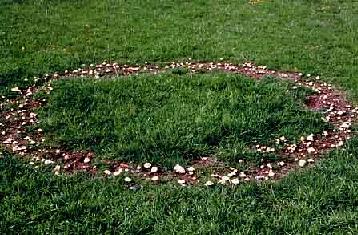
The photo at the left has a fairy ring of
mushrooms, but the grass is dead where the mushrooms are visible. This
sometimes happens when the edge of a dense mycelium grows above the
grass roots, thus preventing the water from getting down to the roots. If
it is true in this case, the situation does not exist in the center of the
mycelium.
[S]
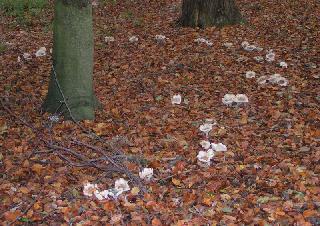
A fairy ring can also be in a woods. This one surrounds a tree. [S]
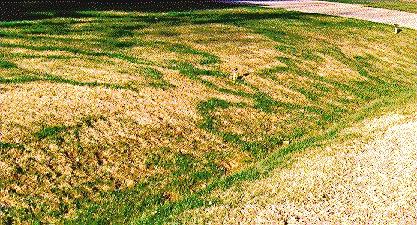
This lawn in Spring shows many fairy rings
before the mushrooms appeared.
[S]

Visitors since 17
Apr 2006
Go to Grandpa Cliff's Website for Teenagers (HOME)
Read more details about fairy rings [S]
Albany, NY